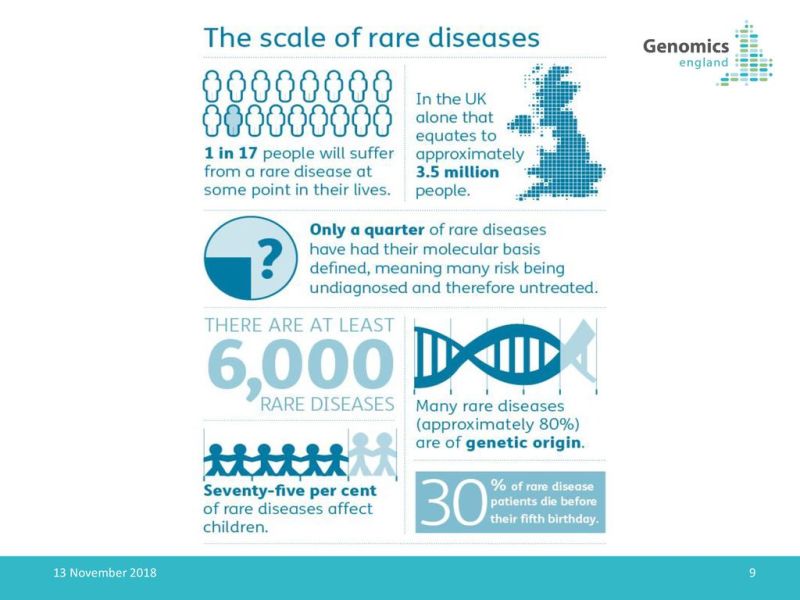What Is A Rare Disease – Article by: Alastair Kent OBE FRSA, Chair of Congenica’s Patient Advocacy Advisory Board and former Chief Executive of Genetic Alliance UK. I would like you to put yourself in the shoes of families/patients and parents with children or family members with life-limiting disorders. Some of you will be parents or expect to be parents at some point in the future. Perhaps you are an aunt or uncle of a child or you may have friends who have children. Whatever relationship you are in, children are life changing. When you find out that you are going to have a child, the first hope for parents is that the child will be healthy. It will have one of the things that should have one, two of the things that should have two of , and they will all be arranged in a more or less conventional way. Fortunately, in developed health economies, most children are born healthy. But unfortunately, sometimes our biology lets us down and we have a child born with a life-limiting condition, either as a result of genetic or environmental issues or a combination of these or other factors. But remember, this is not a choice people make. No one says, “We have a healthy boy and girl, let’s have a child with a life-limiting condition. It will be an interesting challenge!” When it happens to you, it’s a life-changing event that you have to deal with, but it’s not because Although some families may be aware of a pre-existing family risk, for most people, they are unaware of any family risk. When a life-limiting condition is identified, it is a moment of trauma, a moment of uncertainty of fear and the families need to understand what the future will bring to them and is it treatable? The sad thing is that , individually rare diseases are rare, sometimes they only affect a small number of people in a population, because there are so many rare diseases, at least 7000 and more are identified every month, rare diseases are not so rare in society: they affect the 1 in 17 newborn babies. If you look at the literature, you’ll see that three-quarters of rare diseases begin in childhood. Unfortunately, of them, at least 30% of children who have a rare disease die before their fifth birthday, so imagine the impact of losing a child on a family. Around 80% of these rare diseases are genetic in origin, meaning that they not only affect the individual with the disease, but there is a familial risk that runs from generation to generation and between family members. Although there have been great advances in our understanding of the biology of many of these rare diseases, around 95% still have no effective disease-modifying treatment. The problem you have is that while all doctors will know families affected by rare diseases, it is impossible to predict which rare diseases they will encounter during their careers. As such, you can’t expect most doctors to automatically understand the condition that has manifested itself in you, your child, or your loved ones, so families often struggle to get a diagnosis. People affected by rare diseases can wait months or years to receive a diagnosis; they may visit various specialists for tests and procedures, which can be invasive, painful and require general anesthesia. Frequently, missed diagnoses are made, sometimes more than one misdiagnosis. You can imagine that if you are misdiagnosed, your doctors are working in the dark. You may miss opportunities to understand and receive interventions that can help. For example, if something can be done, you’re missing out on doing it in a timely manner because, for certain disorders, early interventions can prevent irreversible symptoms. In fact, you may receive advice, treatment or support that does not help, as it may refer to an illness that your child does not have. It can even aggravate this disorder. You can’t plan because you don’t know what the future holds. Is the disorder progressive, will it happen again in another child? Will the child continue to develop in a more normal way, or will there be serious problems in the future? As such, you get poorer access to services and support because you don’t know what the problem is and you struggle to find someone who can say, “I know what this is, this is what it means, this is what we can do. !” This is where genomics in general, and Congenica in particular, is a game changer.
In recognition of Rare Disease Day, Congenica looks at the importance of a genetic diagnosis for patients and asks, what’s next for rare diseases?
What Is A Rare Disease

For International Day of Women and Girls in Science, we spoke to three women from Congenica about their experiences working in STEM.
Life With A Rare Disease
Professor Matthew Hurles, project lead for the DDD study and founder of Congenica, discusses his projects, advances in data analysis and interpretation August 19, 2015 Rare diseases and misdiagnosis – A chart by Isabel There are between 6,000 and 8,000 known rare diseases – defined as a disease that affects fewer than 5 in 10,000 people, with more being discovered every week. Many rare diseases are difficult to diagnose, both because there isn’t as much research available about them, and because they often have similar symptoms to much more common conditions. Rare diseases can go undiagnosed or misdiagnosed for a long time, sometimes resulting in fatality for the patient. Isabel Maude, the inspiration behind Isabel Healthcare, was lucky, but not everyone. The best way to combat misdiagnosis of rare diseases is to improve the physician’s diagnostic process, helping them to consider rare diseases that they might not have thought of themselves. That’s where Isabel comes in, of course. We’ve put together a chart with some rare disease and misdiagnosis facts and figures, and ways Isabel can help fight misdiagnosis. Learn more about Isabel’s Diagnostic Checklist here, with our white paper on Diagnostic Decision Support Tools:
Jason is the CEO and co-founder of Isabel. Before co-founding Isabel, Jason spent 12 years working in finance and investment banking across Europe. His daughter Isabel became seriously ill following a misdiagnosis in 1999 and this experience inspired Jason to leave his career in the City and set up Isabel Healthcare Ltd.
Virtual triage: do more questions lead to better patient outcomes? One of the common misconceptions about virtual triage/symptom checking tools is that the more…
Webinar: Using Virtual Triage to Transform Patient Access Outdated contact centers are creating problems for today’s healthcare systems. Like longer waiting time..
Clinical Trials In Rare Disease & Sites Worldwide
Start Your FREE Trial Today Try the Isabel Pro DDx Generator for 30 days. No payment card details required. A disease is rare if it affects less than five in 10,000 people. Although estimates of the number of rare diseases can vary between countries and studies, due to different definitions and challenges with data collection, there are prominently cited as more than 7,000 different rare diseases.
The increasing precision of genomic technologies means that new diseases are regularly discovered. While individual diseases may be rare, the total number of Australians living with a rare disease is not. About eight per cent of Australians live with a rare disease. Extrapolated to an Australian population of over 25 million people, this equates to about two million Australians.
Approximately 80 percent of rare diseases are genetic in origin. Types of non-genetic rare diseases include cancer, infections and autoimmune disorders.

Rare diseases, like many other chronic diseases, are often severe and progressive. They typically present a high level of symptom complexity and are therefore a significant cause of ongoing health and psychosocial problems. There is no cure for many rare diseases, so improving the quality of life and extending the life expectancy of people living with a rare disease depends on appropriate treatment and care.
Million People Suffer From Rare Diseases. Here’s How Tech Can Help
Note: The above information was taken from the National Strategic Action Plan for Rare Diseases (page 9). © Commonwealth of Australia (Department of Health) 2020.
The Rare Awareness Rare Education (RARE) portal contains current, reliable and direct information and resources for all stakeholders in rare diseases. More information and resources will follow
Is als a rare disease, is hiv a rare disease, what is rare blood disease, is hemophilia a rare disease, what is rare disease, what is a rare autoimmune disease, is lupus a rare disease, what is rare genetic disease, what constitutes a rare disease, is ms a rare disease, what is considered a rare disease, is sarcoidosis a rare disease






